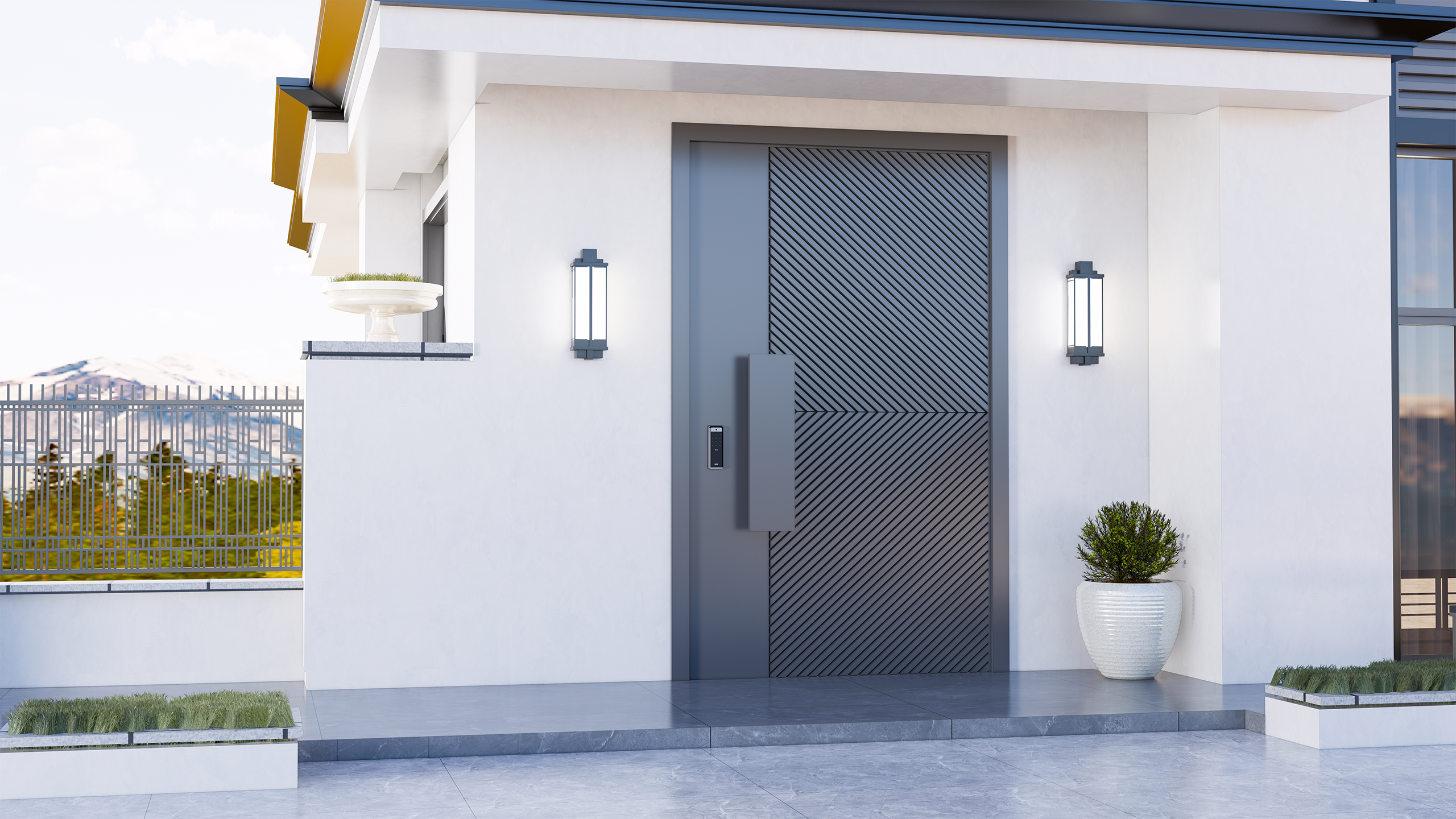What is an entrance door?

Introduction to Entry Door
What is an Entrance Door?
An entrance door is the primary door that provides access to your home or building. It is the first thing people see when they approach your property, making it an essential part of both your home’s function and aesthetic appeal. These doors come in a wide variety of styles, materials, and sizes, catering to different tastes and needs. Whether it’s a wooden entrance door, a metal entrance door, or a cast aluminum entrance door, the choice you make will significantly impact your home’s overall look and feel.
Beyond simply providing entry, an entrance door plays a critical role in your home’s security and energy efficiency. In essence, it acts as the gateway to your private space, providing protection from the elements and intruders and maintaining your home’s temperature.
Simply put, the entry door is more than just a way to get in and out of your home. It’s an essential element that combines style, safety, and function.
Why is the Entrance Door Important?
The entrance door is much more than just an entry point. It serves several key functions that affect your home’s safety, energy usage, and curb appeal.
First, it provides security. A strong, well-constructed entrance door keeps unwanted guests out, while advanced locking systems and materials like steel or cast aluminium can give extra protection.
Next, it helps with energy efficiency. A well-insulated entrance door keeps the cold out in winter and the heat in during summer, which can lower your energy bills. Many modern doors offer superior insulation with features like double-glazing or foam cores.
Finally, the entrance door is an integral part of your home’s aesthetic. It’s often the first thing guests notice, setting the tone for the rest of the house. Choosing a stylish door can boost your home’s curb appeal, potentially increasing its value. A carefully selected entrance door can make your home look inviting, elegant, or even modern, depending on your style preferences.
The Role of an Entrance Door in Home Design
The entrance door plays a vital role in the overall design of your home. It is not just a functional element; it’s a statement piece that can influence the entire look and feel of your property.
In terms of style, the entrance door can reflect the personality of the homeowner and set the tone for the rest of the house. A modern entrance door with sleek lines and cast aluminum panels can create a contemporary look, while a wooden entrance door might evoke a more rustic, traditional feel. Even the color and finish of the door can complement or contrast with the home’s exterior, creating a harmonious or striking visual appeal.
Moreover, the entrance door often serves as a focal point for the front facade of your home. It draws attention, welcoming visitors while giving them a glimpse of what’s inside. In this way, the entrance door acts as a bridge between the outside world and your personal living space, combining functionality with design.
Types of Entrance Door
Wooden Entrance Door

Wooden entrance doors are classic choices that offer warmth and elegance to any home. These doors are made from various types of wood, such as oak, mahogany, or pine, each with its unique appearance and feel. A wooden entrance door instantly adds character to your home’s exterior, often giving it a timeless, inviting look.
One of the biggest advantages of a wooden entrance door is its natural beauty. Wood’s rich texture can be enhanced with stain or paint, allowing homeowners to match the door with their style or the surrounding environment. Additionally, wood provides excellent insulation, keeping your home warmer in the winter and cooler in the summer.
However, wooden doors do require regular maintenance. They need to be re-stained or repainted over time to protect against moisture, warping, and potential damage from the elements. Still, with the proper care, a wooden entrance door can last for many years, offering both beauty and functionality.
Metal Entrance Door
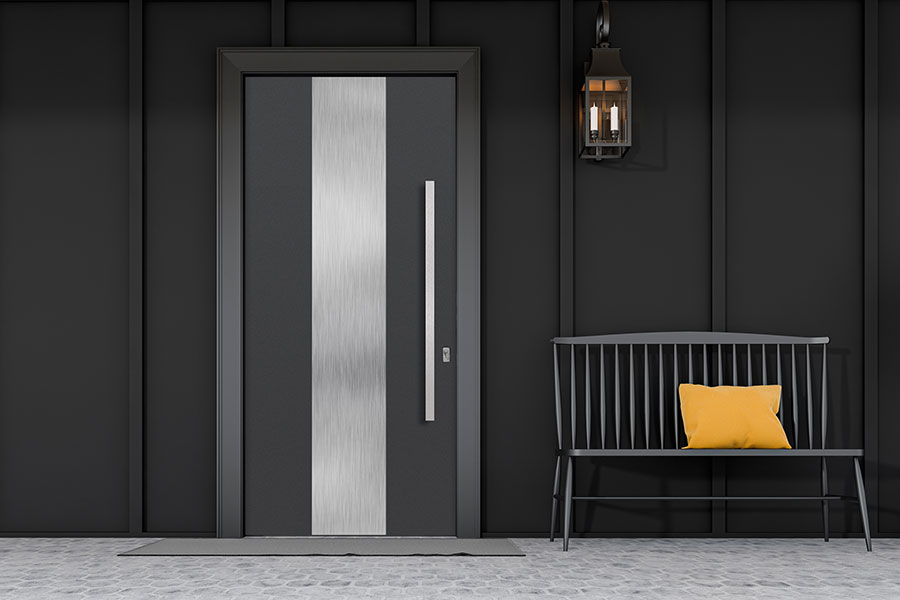
Metal entrance doors are known for their strength, durability, and security features. Made from materials like steel or aluminum, these doors provide a higher level of protection against break-ins and harsh weather conditions. For many homeowners, security is a top priority, and a metal entrance door is an excellent choice because of its solid, reinforced structure.
One significant benefit of a metal entrance door is its low maintenance. Unlike wooden doors, metal doors do not require constant painting or sealing. They are naturally resistant to pests like termites and do not warp or swell when exposed to moisture. Steel doors, in particular, are often equipped with advanced locking systems, further enhancing security.
The downside is that metal doors can be prone to dents and scratches, especially in high-traffic areas. However, many modern metal entrance doors come with protective coatings that help reduce damage and maintain their appearance for longer.
Cast Aluminum Entrance Door

A cast aluminum entrance door offers a unique combination of strength and style. Unlike typical metal doors, cast aluminum doors are made using a specialized molding process, which results in a highly durable and lightweight structure. These doors often feature intricate designs, making them an excellent option for homeowners looking for a decorative touch in addition to security.
The style of your entry doors play a significant role in the overall aesthetic of your home. There are many styles to choose from, and each brings its unique character to the exterior of your home. Here are some of the most popular entry door styles:
The main advantages of a cast aluminum entrance door include its resistance to corrosion and its ability to withstand extreme weather conditions. Aluminum does not rust, which makes it ideal for homes in areas with high humidity or coastal regions where saltwater can damage other materials. Furthermore, cast aluminum doors are incredibly lightweight, making them easier to install and operate compared to heavier materials like steel.
Cast aluminum entrance doors come in various styles, including painted or anodized options. Customising the finish and design allows homeowners to create a unique entrance that reflects their taste.
Stainless Steel Entrance Door
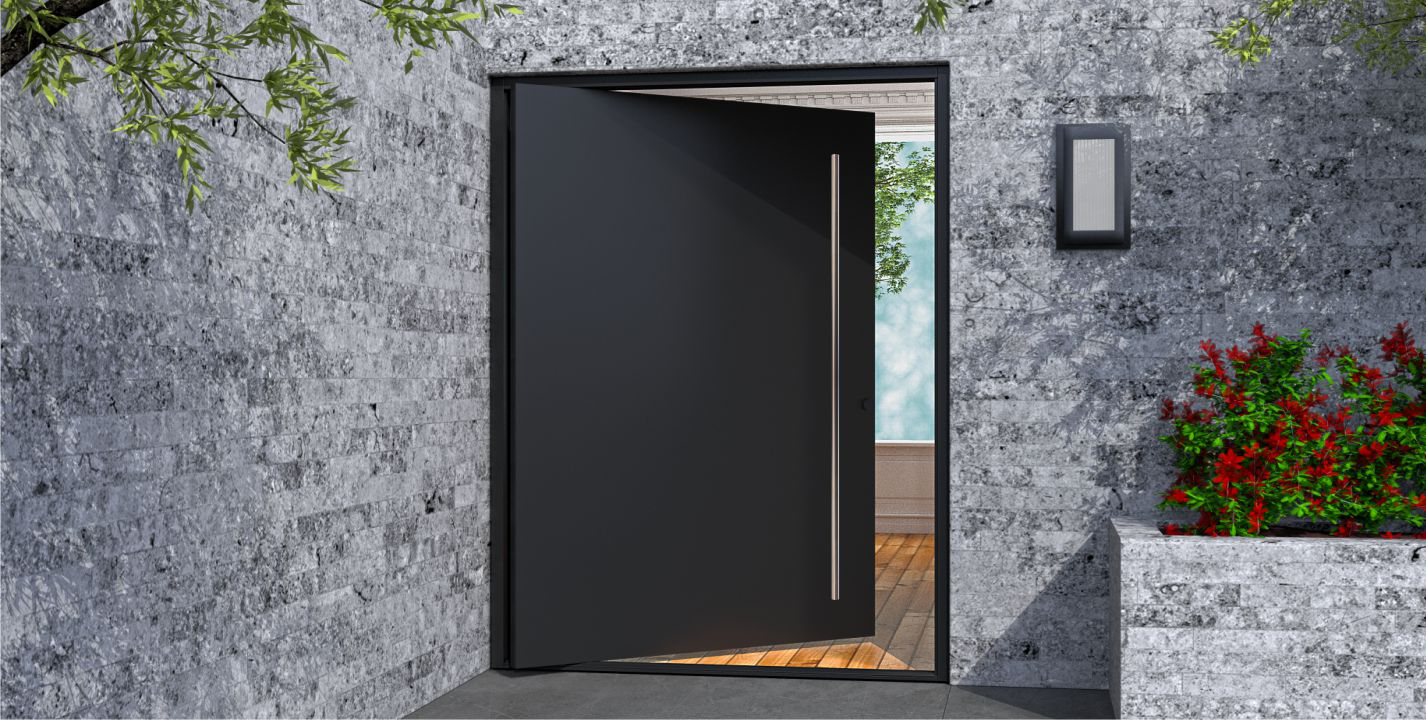
Stainless steel entrance doors are a popular choice for homeowners looking for a blend of modern design, durability, and security. Known for their sleek, contemporary look, these doors provide a strong, long-lasting solution for protecting your home while enhancing its curb appeal.
One of the standout features of stainless steel entrance doors is their exceptional strength. Stainless steel is highly resistant to dents, scratches, and general wear and tear, making it an excellent option for high-traffic areas or homes in environments prone to harsh conditions. This durability ensures that your entrance door can withstand the test of time without losing its functionality or appearance.
How to Choose the Right Entrance Door for Your Home?
Factors to Consider When Buying an Entrance Door
Choosing the right entrance door for your home is an important decision. It affects both the security and curb appeal of your property. Here are some key factors to consider when buying an entrance door:
1. Material:
The material of your entrance door plays a significant role in its durability and appearance. Wooden doors offer a warm, traditional look, but they may require more maintenance. Metal entrance doors, like steel or stainless steel, are known for their strength and security. Fiberglass doors are also a popular choice due to their durability and energy efficiency. Consider your home’s style and the level of protection you need when choosing the material.
2. Security Features:
Your entrance door should provide solid protection. Look for a door with strong locking mechanisms and durable construction. Features like multi-point locks, deadbolts, and reinforced frames can significantly increase its security. If security is a top concern, metal entrance doors or smart entrance doors with advanced locking systems might be the best option.
3. Energy Efficiency:
An energy-efficient entrance door can help keep your home comfortable while lowering your energy bills. Look for doors with insulation, double or triple glazing, and weatherstripping to prevent drafts. Fiberglass and composite doors are often good choices for energy efficiency.
4. Style and Design:
Your entrance door should complement the overall design of your home. Think about the architectural style of your house and the kind of first impression you want to make. Modern homes might benefit from sleek glass entrance doors, while traditional homes may look better with a wooden entrance door. Choose a design that enhances your home’s curb appeal and matches your taste.
5. Budget:
Entrance doors come in a wide range of prices. Determine your budget before you start shopping. While more expensive doors often offer better security and energy efficiency, there are also affordable options that still provide good value. Make sure to balance your budget with the features that are most important to you.
6. Climate:
The climate in your area is another critical consideration. For homes in humid or coastal environments, stainless steel or cast aluminum doors might be the best choice, as they are resistant to rust and corrosion. In colder climates, insulated entrance doors will help keep your home warm and prevent heat loss.
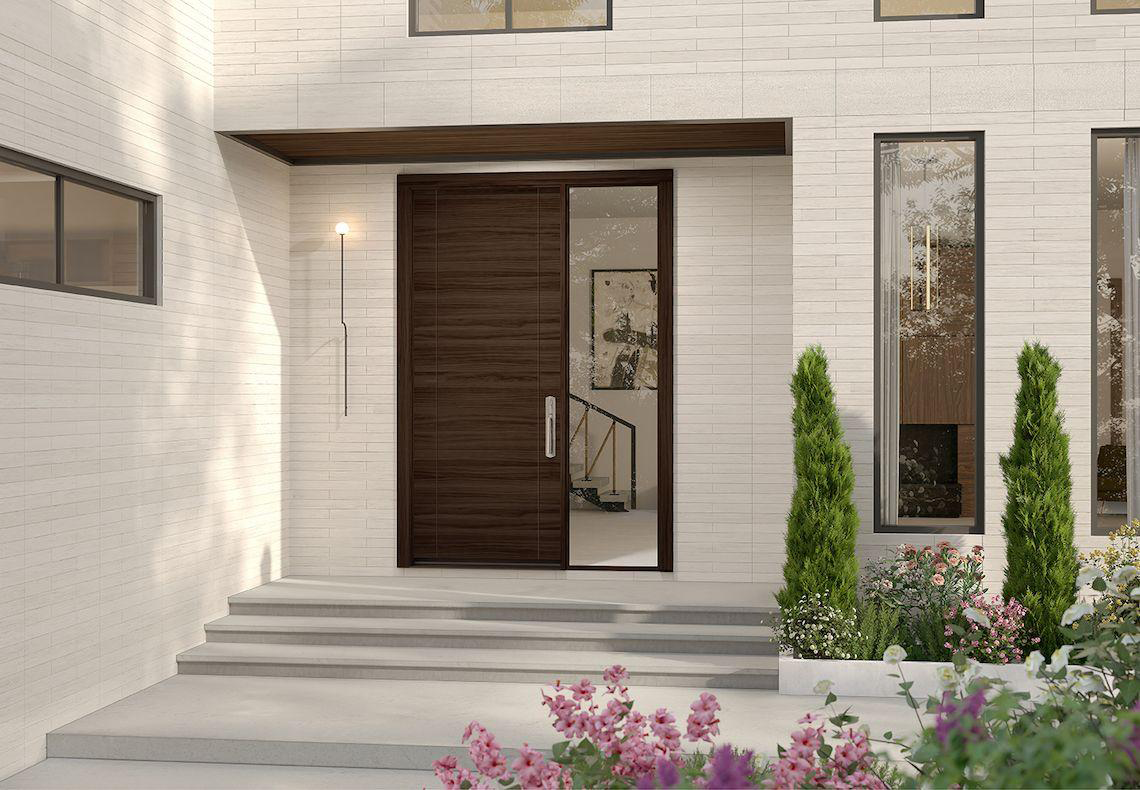
Tips for Measuring Your Door Frame Properly
Correctly measuring your door frame is crucial when buying an entrance door. A door that doesn’t fit the frame properly can lead to issues with insulation, security, and appearance. Here are some tips to make sure your measurements are accurate:
1. Measure the Door Width:
Start by measuring the width of your door frame. Use a tape measure to measure from one side of the frame to the other at three different points: top, middle, and bottom. Record the smallest measurement to ensure your new entrance door fits correctly.
2. Measure the Door Height:
Next, measure the height of your door frame. Measure from the floor to the top of the frame at three points: left side, middle, and right side. Again, use the smallest measurement for accuracy.
3. Check the Door Depth:
The thickness of your door frame is another important dimension. Measure the depth from the front of the frame to the back. This will help ensure that the new entrance door fits securely and doesn’t leave any gaps.
4. Consider the Threshold:
Remember to measure the threshold, the bottom part of the door frame. Make sure your new door will be compatible with the existing threshold. If the threshold is damaged or worn, you may need to replace it along with the door.
5. Check the Opening Angle:
When measuring, account for the door’s swing direction. If the door swings inward, check that there is enough space inside for it to open fully. If the door swings outward, ensure that there is no obstruction outside.
6. Take Measurements Twice:
It’s always a good idea to double-check your measurements before ordering your new entrance door. Accurate measurements are essential to avoid any surprises during installation.
Summary
By following these simple steps, you can ensure that the entrance door you choose fits your home perfectly and provides both security and aesthetic appeal. Correctly measuring your door frame helps avoid costly mistakes and ensures a smooth installation process.

Entrance Door Security Features
The Importance of Security in an Entrance Door
When it comes to your home, the entrance door plays a critical role in protecting you and your family. It’s the first line of defence against unwanted intruders and harsh weather conditions. That’s why security features in an entrance door are so important. A well-designed entrance door can deter burglars and provide peace of mind, knowing that your home is safe and secure.
The entrance door is the most vulnerable part of your home’s exterior. It’s essential to choose a door that offers strength, stability, and solid security features. High-quality metal entrance doors, such as steel or stainless steel doors, are often preferred for their durability and resistance to forced entry. These doors can be reinforced with multi-point locking systems, security bolts, and heavy-duty hinges, making it much harder for burglars to break through.
Another important security feature is the door frame. A strong, reinforced door frame works in tandem with a solid entrance door to prevent intrusions. A weak or poorly installed frame can easily compromise the door’s security, no matter how strong the door itself is.
It’s also worth considering the lock systems you choose for your entrance door. Deadbolt locks, smart locks, and keyless entry systems all offer different levels of security. Modern entrance door locks can be highly effective in preventing unauthorized access, especially when paired with reinforced doors and frames.
Ultimately, the goal is to select an entrance door that enhances your home’s physical and psychological security. A strong door, combined with the right security features, will not only protect your home from break-ins but also give you confidence that your family is safe.
Smart Entrance Door
Smart entrance doors are a game-changer in home security. These innovative doors come with advanced technology that adds an extra layer of convenience and safety. They can be controlled remotely and often come equipped with features like keyless entry, video surveillance, and smart locking systems.
One key benefit of a smart entrance door is the ability to manage access to your home from anywhere. Using your smartphone or a dedicated app, you can lock and unlock your door, monitor who is entering and leaving, and even grant temporary access to guests or service personnel. This is especially useful for busy homeowners who want to keep track of who is coming and going without physically being there.
Many smart entrance doors feature video doorbells or cameras, allowing you to see and speak with visitors before granting them access. This adds an extra level of security, as you can verify the identity of anyone at your door, even if you’re not at home. Some systems also include motion sensors, which alert you to any unusual activity around your entrance door.
In addition to offering enhanced security, smart entrance doors are highly convenient. With keyless entry, you no longer need to worry about losing your keys or fumbling around to unlock the door. Some systems also integrate with home automation platforms, allowing you to connect your door to other smart devices, like lights, alarms, or thermostats.
For those who value both security and convenience, a smart entrance door is a modern solution that makes home entry more seamless and safe. Combining cutting-edge technology and solid security features, these doors offer homeowners a new level of control and peace of mind.
Maintenance and Care for Entrance Door
How to Maintain a Wooden Entrance Door?
Wooden entrance doors are known for their timeless beauty and warmth. However, they do require regular maintenance to keep them looking their best and functioning properly. Here are a few simple tips to ensure your wooden entrance door stays in top shape.
First, it is essential to clean your wooden door regularly. Use a soft cloth or a gentle sponge with mild soap and water to wipe off dirt and grime. Avoid harsh chemicals, as they can damage the wood finish. After cleaning, dry the door thoroughly with a soft towel to prevent water from soaking into the wood, which can cause warping.
Next, it’s crucial to reapply a protective finish or sealant every few years. This will help protect the wood from moisture and temperature changes, which can cause cracks or swelling. If your wooden entrance door has been exposed to heavy rain or snow, consider applying a fresh coat of varnish or wood oil to keep the door sealed and looking great.
Additionally, check for any signs of wear or damage. Wooden doors can develop cracks or dents over time, especially in areas with extreme weather. If you notice any damage, repair it promptly using wood filler or by sanding the surface smooth. Regularly inspect the door’s hinges and locks to make sure they are in working order, and lubricate them as needed.

Maintaining Cast Aluminum Entrance Door
Cast aluminum entrance doors are highly durable and require much less maintenance than wooden or steel doors. However, to keep them looking their best, a little care goes a long way. Here are a few tips for maintaining your cast aluminum entrance door:
Start by cleaning your cast aluminum entrance door regularly. Use a mild detergent and a soft cloth to wash away dirt and dust. Avoid abrasive cleaners or scrubbing tools, as these can scratch the surface. For tougher stains or dirt buildup, a mixture of water and vinegar can be an effective natural cleaner that won’t harm the finish.
Another advantage of cast aluminum doors is their resistance to rust. Unlike steel or iron, aluminum doesn’t corrode when exposed to moisture. However, it’s still a good idea to check for any signs of surface oxidation or buildup, especially in coastal areas with salty air. If you spot any corrosion, gently scrub it away with a non-abrasive pad and apply a protective coating to prevent further damage.
If your cast aluminum entrance door has a painted finish, be mindful of chipping or fading. Over time, the paint may begin to wear, particularly in high-traffic areas. Touching up the paint with a matching color can keep your door looking fresh and prevent further damage to the metal underneath.
Lastly, inspect the door’s seals and weather stripping regularly. These components help maintain your home’s energy efficiency by blocking drafts. If you notice any cracks or damage, replace them promptly to keep your home comfortable and energy-efficient.
Caring for Stainless Steel and Metal Door
Stainless steel entrance doors and other metal entrance doors are known for their strength and low maintenance needs. Still, a bit of care will keep them looking polished and ensure they function well for years. Here are some tips for maintaining these doors:
Start by cleaning your stainless steel or metal entrance door with a soft cloth and mild detergent. Avoid using abrasive sponges or harsh chemicals, as these can scratch the surface. A specialized cleaner can help maintain stainless steel doors’ shiny, fingerprint-free finish. Make sure to wipe the door down after cleaning to avoid streaks or water spots.
One of the most significant advantages of metal entrance doors, including stainless steel, is their resistance to rust and corrosion. However, if you live in an area with high humidity or near the ocean, it’s still worth checking the door regularly for signs of corrosion. If you spot any, treat the affected area with a rust remover or clean it with a mixture of vinegar and water. Applying a protective wax coating or sealant can help prevent rust from forming in the future.
In addition, check the door’s hinges, locks, and seals to ensure they are functioning correctly. Metal doors can sometimes develop issues with hinges or locks over time, so it’s a good idea to lubricate moving parts every few months. This will prevent squeaking and ensure smooth operation.
If your metal entrance door has any dents or scratches, it’s essential to address them quickly to prevent further damage. For stainless steel doors, a light buffing with a fine polishing cloth can remove minor imperfections. For other metal doors, touch-up paint can help restore the finish and prevent rust from forming.
Common Problems with Entrance Door and How to Fix Them
Drafts and Poor Insulation
One of the most common issues with entrance doors is drafts. If you feel a cold breeze around your door, especially in the winter, it is likely, that your entrance door is not correctly insulated. Poor insulation can lead to higher energy bills as warm air escapes during the colder months or incredible air escapes in the summer.
The first step to fixing drafts is to check the weather stripping around your entrance door. Over time, the weather seal may become worn out or damaged, allowing air to seep through. Replacing the weather stripping is an easy and affordable fix. Remove the old seal and install a new one that fits tightly around the edges of the door. This will significantly reduce drafts and improve the door’s overall energy efficiency.
Another potential cause of drafts is gaps around the door frame. These can develop due to settling or warping of the wood or metal over time. You can fill these gaps with caulk or foam sealant, which are both inexpensive solutions. For larger gaps, replace the door frame or install a new door that fits more securely.
Finally, if your wooden or metal entrance door is not insulated, you might want to consider adding an insulation panel or replacing the door with an energy-efficient option. Many modern doors come with built-in insulation, which is much better at keeping drafts out and reducing energy loss.

Squeaky Hinges and Difficult Locks
Another common issue with entrance doors is squeaky hinges or difficult-to-operate locks. These problems not only make your door less functional but can also be annoying to deal with on a daily basis.
The solution for squeaky hinges is simple: Apply a small amount of lubricant, such as WD-40 or a silicone-based spray, to the hinges. Open and close the door several times to work the lubricant in. This will stop the squeaking and allow the door to open and close smoothly. If the hinges are particularly worn out or damaged, you might need to replace them with new ones.
Difficult locks can be a bigger problem, but they’re usually easy to fix. If the lock is sticking or difficult to turn, try cleaning the keyhole with compressed air to remove dirt or debris. Then, apply a small amount of graphite powder to the lock. This should help the key slide more easily and prevent it from sticking.
If the entrance door lock is still problematic, you might need to lubricate the internal parts with a silicone-based lubricant. Avoid using oil-based lubricants, as they can attract dust and cause more problems in the long run. For more serious issues with the lock mechanism, consider having a professional locksmith inspect and repair it.
Relate FAQ
Why is an entrance door important?
An entrance door is crucial for security, privacy, and curb appeal. It acts as the first line of defense against intruders and weather elements while also contributing to the overall aesthetic of the home or building.
What materials are commonly used for entrance doors?
Common materials for entrance doors include wood, stainless steel, cast aluminum, and metal. Each material offers different benefits, such as durability, insulation, and style.
How do I choose the right entrance door?
To choose the right entrance door, consider factors like security features, material durability, energy efficiency, and aesthetic appeal. It’s also important to consider your area's climate, as some materials perform better in specific weather conditions.
Can entrance doors be customized?
Yes, entrance doors can be customized to fit your specific needs. Customization options include different sizes, materials, colors, finishes, and security features such as smart locks or reinforced frames.
What is the difference between a front door and an entrance door?
The terms "front door" and "entrance door" are often used interchangeably, but an entrance door can refer to any door leading into a building, while a front door specifically refers to the main door at the front of a house or building.
How can I improve the security of my entrance door?
To improve the security of your entrance door, you can install solid-core doors, high-quality locks, deadbolts, and security cameras. Adding a peephole or smart doorbell can also enhance your safety.
What are the latest trends for entrance doors?
Some of the latest trends for entrance doors include modern minimalist designs, larger glass panels for natural light, energy-efficient doors, and high-tech features like keyless entry and smart locks.
How often should I replace my entrance door?
You should consider replacing your entrance door when it shows signs of significant wear, such as warping, rust, or difficulty opening/closing. Typically, a well-maintained door can last 30 years or more.
